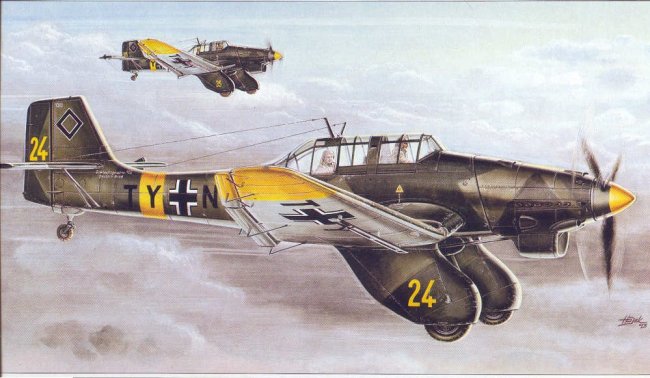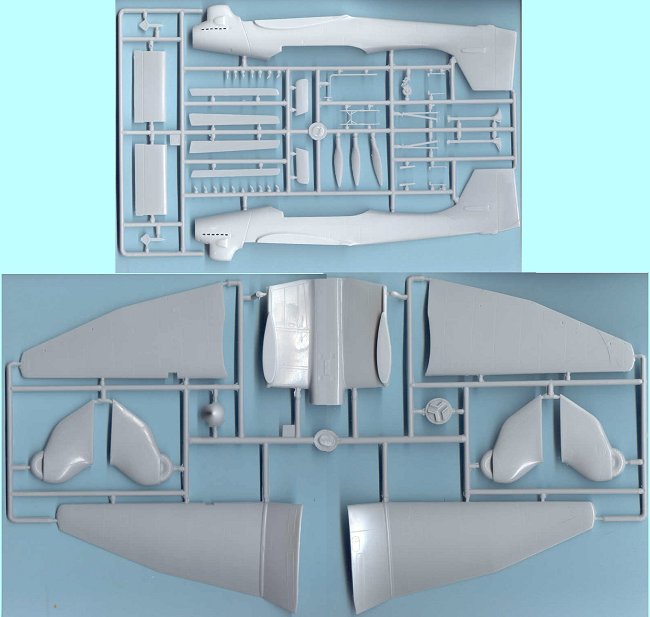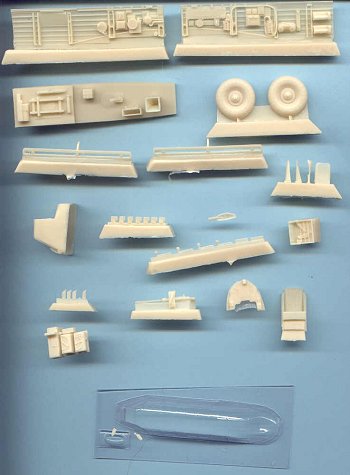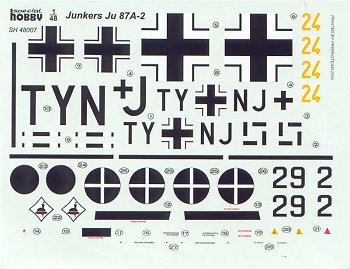
|
KIT: |
Special Hobby 1/48 Ju-87A 'Stuka' |
|
KIT # |
48007 |
|
PRICE: |
$32.95 |
|
DECALS: |
2 aircraft: St.G. 163, Spain, 1938; I/SG102, Eastern Front 1943-44. |
|
REVIEW & PHOTOS BY: |
|
|
NOTES: |

|
HISTORY |
Few German aircraft of the Second World War are better known to those who know little about that conflict than the famous Junkers "Stuka." The evocative name, short for Sturzkampfflugzeug, a term descriptive of dive bombers in general, came to be associated with an airplane that conquered nations, associated forever with the concept of the Blitzkrieg, and the destruction of Poland and France, blasting Allied armor and defenses, paralyzing armies, playing havoc with communications, and hounding the streams of refugees that made it all but impossible for the Polish or French armies and the B.E.F. to mount an effective defense. Yet within a matter of months of its victories in France, the Stuka was revealed over England for what it was: slow, unwieldy, the natural prey of the fighter. It was an airplane that required air superiority for it to operate successfully. When this condition was met, it was a terrific weapon in the hands of trained crews, a horrific ship killer in the Mediterranean, and scourge of tanks on the Eastern Front.
The prototype Ju-87 flew in 1935, primarily under the aegis of Ernst Udet, the foremost advocate of divebombing in the Luftwaffe. The initial production model, the Ju-87A-1, was powered by the 635 h.p. Junkers Jumo 210Da engine; production delivery commenced in the spring of 1937 to the Sturzkampfgeschwader Immelmann. That December, three of the Ju-87A-1 Stukas of St.G. Immelmann were sent to Spain for field testing of dive bomber theory.
In Spain the three Ju-87s first participated in the Battle of Teruel, and were subsequently involved in the drive to the Mediterranean coast, the fighting on the Ebro Front and the drive into Catalonia. Many different crews flew the three aircraft in order that the maximum number of personnel would obtain combat experience. The aircraft proved deadly in operations against bridges and road crossings, as well as staff headquarters and ships. Movement of troops in Spain was heavily dependent on the roads, so any disruption would disrupt movement.
Only some 200 Ju-87A-1 and A-2 aircraft were built before they were replaced by the definitive Stuka, the Ju-87B, in the summer of 1938. St.G. Immelmann used their Ju-87As in the Sudeten Crisis and the subsequent occupation of the Sudetenland. By the outbreak of war in Poland, the Ju-87A had been relegated to the training units, though some were used in anti-partisan campaigns on the Eastern Front in 1943-44.
|
THE KIT |

 I have long wanted to see
a 1/48 kit of the first Stuka, which is an interesting-looking airplane with its
massive "trousers" around the main landing gear. There was a vacuform
released in the 1980s, but other than that I am not aware of any other kits of
the Ju-87A prior to this one from MPM.
I have long wanted to see
a 1/48 kit of the first Stuka, which is an interesting-looking airplane with its
massive "trousers" around the main landing gear. There was a vacuform
released in the 1980s, but other than that I am not aware of any other kits of
the Ju-87A prior to this one from MPM.
MPM has been praised in the past for the petite surface detail of their kits, and damned equally strongly for the poor fit of many of kits - several of which seem to have never been the subject of a test build prior to being placed in production; additional complaints about excessive flash and roughness of interior surfaces have generally kept many modelers from attempting kits from this company. No more! This kit is as much an advance in design and production quality over what has been released previously by MPM as the Sopwith Triplane was an advance for Eduard kits. With the increased effort displayed in the Classic Airframes Blenheim (MPM does the design and production of CA kits), followed by this kit from Special Hobby (part of the MPM kit line), it is not unreasonable to believe MPM has graduated to the ranks of advanced limited-run plastic model companies.
The kit comes on two sprues of light grey plastic, with parts that have petite engraved detail, are flash-free and demonstrate excellent production quality. The entire cockpit interior is done in crisp resin parts, with a single well-molded vacuform canopy. Test-fitting of parts shows they fit well enough that the completed model should be able to sit next to any of the Hasegawa Stuka models. Decals are provided for one of the three Ju-87A-1s used in Spain, and for a Ju-87A-2 used on the eastern front for Stuka training and anti-partisan operations in 1943-44.
 My only complaint about
this kit is the same complaint I have about the Hasegawa Stukas: they are too
"clean" as regards surface detail. The Stuka was not flush-riveted,
and was covered with a mass of rivet heads. To tell the truth, the old Airfix
Ju-87B-2 Stuka kit from the early 1980s has the best and most accurate surface
detail of any Stuka kit.
My only complaint about
this kit is the same complaint I have about the Hasegawa Stukas: they are too
"clean" as regards surface detail. The Stuka was not flush-riveted,
and was covered with a mass of rivet heads. To tell the truth, the old Airfix
Ju-87B-2 Stuka kit from the early 1980s has the best and most accurate surface
detail of any Stuka kit.
Be that as it may, this kit will make up into a more than acceptable model, the first version of one of the Second World War's most famous aircraft. This kit is highly recommended.